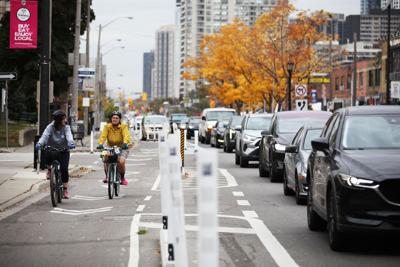Premier Doug Ford’s bid to tear up city bike lanes could cost taxpayers tens of millions of dollars, make commuting in the city more dangerous and achieve only “minor” improvements to traffic speed long-term, a new report from the city contends.
It estimates that ripping up bike lanes on Yonge Street, Bloor Street and University Avenue would cost┬ĀOntario taxpayers $48 million┬ĀŌĆö on top of the $27 million the city spent┬Āinstalling the lanes.
The report, released Wednesday by the city manager’s office and attached to a motion from the mayor, marks an escalation in the municipalityŌĆÖs dispute with the province over the future of local cycling infrastructure.
City┬Ācouncil, which resumes Thursday, is set to debate the report.
Ford┬Āhas vowed to dismantle bike lanes┬Āon sections of Bloor, Yonge and University, which his government has said contribute to Toronto’s traffic woes. The province has said it will pay for the work. Ford is also moving to make Ontario municipalities ask for permission to construct new bikeways going forward.
Ford has blamed bike lanes┬Āfor the “crowded streets that are just absolutely insanity right now on Bloor, on Yonge, on University.”
Transportation Minister Prabmeet Sarkaria, who introduced the bike lane removal legislation last month, has argued the bill will stanch the $11 billion ║ŻĮŪ╔ńŪ°╣┘═°loses annually due to congestion, according to┬Āregional board of trade data.
The bill is awaiting royal assent, the final step before becoming law.┬Ā
After the city report was published Wednesday evening,┬ĀSarkariaŌĆÖs office reiterated to the Star the provinceŌĆÖs rationale for removing the lanes from major arterial roads.
“Bike lanes should only go where they make sense,ŌĆØ said Dakota Brasier, SarkariaŌĆÖs director of media relations. “ItŌĆÖs clear that the cityŌĆÖs approach isnŌĆÖt working and we encourage them to listen to the thousands of common sense drivers to help clear our major roads and get people out of traffic.”
In an email to the Star on Wednesday night, Mayor Olivia Chow said that the money needed to remove the lanes could be better spent elsewhere.┬Ā
“With family budgets squeezed across our city, the millions it’s estimated to cost to remove these lanes (and make people less safe on our roads) could be better spent on feeding all kids in our city through our school food program or help to build more housing.”
Speaking to reporters Wednesday morning ahead of the report’s release, Chow called the province’s plan “arbitrary” and said the city intended to put forward evidence of the impact of removing bike lanes.
“They need to look at our numbers,” she said.
“Ripping up our roads will make our congestion worse, especially during the time that you’re ripping it up. It’s costly and it will make our roads less safe for cyclists.”
She reiterated her argument that Ford’s bike-lane legislation is provincial overreach that violates the city’s oversight of its roadways. The cycling network “has been planned for many years, and the City of ║ŻĮŪ╔ńŪ°╣┘═°and Torontonians need respect,” Chow said.
Cost estimates┬Āfrom the city do┬Ānot include additional┬Āfees it said could be incurred to identify, design and construct alternative cycling routes. There would also be other staff and infrastructure costs for redesigning and reconstructing these affected roads to add space for cars where the lanes used to be.┬Ā
According to the report, the $48-million estimate for removing the bike lanes and replacing them with vehicle lanes includes the cost of road reconstruction for sections that “were recently reconstructed and would need to be rebuilt,” as well as road resurfacing on other sections.
The report stressed that the figure was a “preliminary order of magnitude” estimate excluding staff time and was produced after the province posted details of its legislation late last month. It said more information would be required before the estimates could be “relied upon for other purposes.”
“The removal of existing bike lanes will be a complex project that will be challenging to implement within a short-time period, due to planning, design and construction requirements,” the report said.
Removing the lanes has the potential to decrease safety for pedestrians, cyclists and drivers, according to the report. Drivers will be at greater risk of crashing and cyclists are injured far more frequently on roads without bike lanes.┬Ā
In the past 10 years, 28 people have been killed and 380 people have been “seriously injured” while cycling in Toronto, the report said.
It added that 68 per cent of cyclist collisions happened on streets without “safe cycling accommodations.”
Precisely how many Torontonians bicycle to work is a matter up for debate. Based on recent, albeit imprecise, surveys, it appears some amount fewer than four per cent of the city commutes on two wheels.┬ĀBy contrast, 61 per cent of Torontonians drive to work. There would be significant benefits for traffic and the climate, the city report said, if some of these folks instead picked up a bike.
It is “well documented” that even small reductions in the number of vehicles on a road can produce “large improvements” in traffic flow, according to the report.┬Ā
It would then serve Torontonians better to encourage cycling, rather than dismantle cycling infrastructure, it said.
“People who rely on motor vehicle travel also benefit from bikeways when enough other people choose to leave their car at home,” said the report. “Investing in convenient alternatives to driving, such as bikeways and public transit, is a necessary component of a successful traffic congestion management strategy.”
With files from Ben Spurr and Robert Benzie


























To join the conversation set a first and last name in your user profile.
Sign in or register for free to join the Conversation